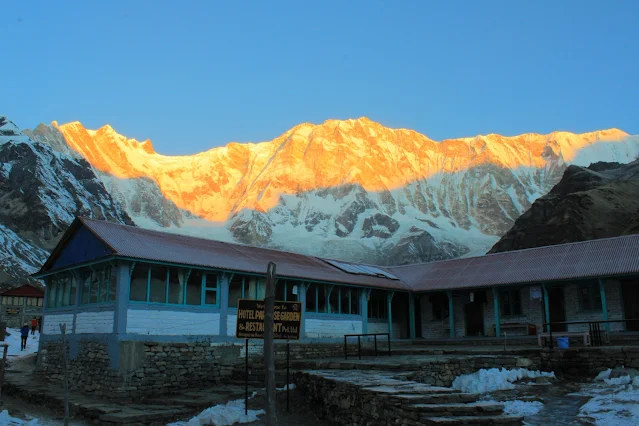Guide to Nepal: trekking, tour, hiking, expedition in Nepal, all free information
Sunday, July 27, 2025
Sunday, March 16, 2025
How Much Does the Everest Base Camp Trek Cost in 2025 and 2026?
Embarking on the iconic Everest Base Camp Trek is a dream for many adventurers. But one of the most critical factors to consider is the cost involved. For the years 2025 and 2026, here's a breakdown of the expected expenses when planning your trek.
Packing List for the Everest Base Camp Trek
Embarking on a trek to Everest Base Camp requires strategic packing to keep you warm, comfortable, and prepared for changing weather conditions. Here's a comprehensive packing guide to help you gear up for this epic adventure.
Essential Items for Your Everest Base Camp Trek
Training Program for Mount Everest Base Camp Trekking
Preparing for the Mount Everest Base Camp trek demands both physical and mental readiness. Here's a comprehensive training guide to help you embark on this adventure with confidence:
How Safe Is It to Embark on an Everest Base Camp Trek?
Embarking on a trek to Everest Base Camp is generally deemed safe for healthy individuals ready to embrace the adventure. However, the journey demands both physical determination and mental resilience due to the challenges presented, particularly by the high altitude.
Understanding Altitude Challenges
Altitude sickness is one of the most unpredictable yet significant concerns on this trek. It can affect anyone, regardless of their fitness level. Symptoms may occur suddenly, and preparation is essential. Being mentally prepared is just as crucial as your physical readiness.
Thursday, April 4, 2024
The Complete Guide to Everest Base Camp Trek: Tips, Routes, and Preparation
Embarking on a trek to Everest Base Camp is not just any adventure—it's the journey of a lifetime that draws hikers from all corners of the globe. Nestled amidst the towering peaks of Nepal, this trek offers unparalleled views of the world's highest mountain, Mount Everest, and gives you a profound appreciation for the majesty of nature. Whether you're a seasoned trekker or it's your first time strapping on hiking boots, the path to Everest Base Camp is filled with breathtaking landscapes, vibrant Sherpa culture, and unforgettable experiences. Before you lace up your boots and hit the trail, there are a few things you'll need to know. Preparation is key, and this guide is designed to give you all the information you need to make your trek successful and enjoyable. From choosing the best route to packing the essentials, we've got you covered. Let's get started on the journey that awaits you in the heart of Nepal.
Tuesday, February 6, 2024
Pathivara and Halesi Darshan Tour
Tuesday, January 9, 2024
TEN THINGS TO KNOW BEFORE GOING TO MARDI HIMAL TREKS
The Mardi Himal trek, situated in the Annapurna region of Nepal at an altitude of (4500m), is renowned for its exceptional natural beauty and majestic mountainous landscapes. This trek offers breathtaking views of the imposing Annapurna South and the towering Machhapuchhre Himal. This expedition offers the opportunity to discover a wide range of Natural diversity, including diverse biodiversity, Mountainous landscapes, and varied terrains, all within a single journey. The Mardi Himal trek offers a unique and valuable experience that is worth undertaking at least once in a lifetime. It is important to be well-informed about the trek before embarking on it. Therefore, here are Ten essential considerations to be aware of before undertaking the Mardi Himal trek.
Monday, December 9, 2019
How to Prepare for Annapurna base camp trek?
Annapurna base camp trek is world popular trekking route which takes you directly to the Himalaya. Its similar to Everest base camp trekking route but much more easier .Complete Guide about Annapurna base camp trek
Sunday, June 2, 2019
Lifestyle in Nepal
Nepal is a small and beautiful country. It lies between India and China.
Nepal has seven states and seventy-seven districts. Nepal has divided in three geographical locations. They are Hilly region, Terai region and Himalayan region.
Nepalese people commonly welcome you by Namaste which as a traditional salute. About 2.3 billions, Nepalese people are made of 69 different cultural groups living in different region of country. They also speak different language, eat different types of food, wear own cultural dress and they follow their own religious practices. They live under different geographical location such as terai, hilly and Himalayan zone.
Sunday, December 23, 2018
Everest Base Camp Trek, EBC Trekking Package in Autumn | Spring
Tuesday, November 20, 2018
Annapurna Base Camp Trek Fly Out - ABC Trekking by Helicopter
Thursday, August 9, 2018
Family Tour in Nepal - Family Tour Package | Holiday
Tuesday, July 31, 2018
Top 10 Popular Activities in Nepal for your Holiday Planning
Sunday, July 22, 2018
Buddhist Cultural Tour in Nepal | Buddhist Circuit Tour
Tuesday, July 3, 2018
Short Annapurna Circuit Trek
Monday, July 2, 2018
Poon Hill Trekking Experience
Read trekkers experience after Ghorepani Poon Hill trekking.


.png)








